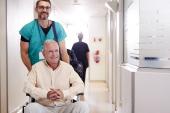‘Right Time, Right Moment’: Same-Day Discharge After TAVI Safe, Feasible
To conserve resources for the critically ill during COVID, some centers began same-day discharge after TAVI in select patients.

Two new studies—one of which will be presented at the upcoming American College of Cardiology (ACC) Scientific Sessions—are highlighting some of the opportunistic changes hospitals made during the peak of the COVID-19 pandemic, when they began to send TAVI patients home the same day as the procedure.
In both studies, one a single-center experience and the other from multiple sites across the United States, Canada, and United Kingdom, same-day discharge TAVI was shown to be safe and feasible, with researchers reporting there was no untoward risk of adverse outcomes between discharge and 30 days.
“In patients who are otherwise functionally well—their main problem is severe symptomatic aortic stenosis without any really significant comorbidities—it’s absolutely safe to mobilize them at 4 hours and send them home the same day,” David Wood, MD (St. Paul’s and Vancouver General Hospital, Canada), senior author of the multicenter PROTECT TAVR study, told TCTMD.
There was no evidence of late conduction delays requiring a permanent pacemaker (PPM), said Wood, noting that only patients at low risk for conduction disturbances and those with a preexisting PPM were sent home on the same day.
Chandan Devireddy, MD (Emory University Hospital, Atlanta, GA), one of the study investigators, said the results with same-day discharge are a reflection of the advances with TAVI in the last decade.
“Across different centers, we can reproducibly achieve a very high procedural success rate with freedom from major complications consistently,” he told TCTMD. “In terms of the risk of pacemaker, which was probably the main criticism of this approach in the early days, with these appropriately selected patients it’s really not something that turned out to be a problem whatsoever. Of those patients that did experience some morbidity within those first 30 days, I don’t think they are [events] that an additional day or two in the hospital would have necessarily prevented.”
Amar Krishnaswamy, MD (Cleveland Clinic, OH), lead author of the study documenting same-day discharge at the Cleveland Clinic, said there is already evidence of safety with that time frame after a number of cardiovascular interventions, including PCI.
The outcomes, I would argue, are unprecedented as far as what we were able to achieve at a time when the world was turned upside down. David Wood
“One of the major hurdles to same-day discharge with TAVI is the need for continued heart rhythm observation,” Krishnaswamy told TCTMD. “In our series, those who developed new left bundle branch block, six of whom were discharged on the same day, all resolved the left bundle [branch block] before they were discharged in the afternoon.”
Patients who require further rhythm monitoring, those who may require in-patient heart failure management after the procedure, and those who are either uncomfortable going home that day, or who lack the social support network at home, would not be eligible for same-day discharge, Krishnaswamy said.
In an editorial accompanying the studies, both of which were published online March 21, 2022, in JACC: Cardiovascular Interventions, Jay Giri, MD, and Paul Fiorilli, MD (Hospital of the University of Pennsylvania, Philadelphia), praise the research groups for doing their investigations at the height of the pandemic. They note that patients in the two studies were very similar in age, sex, STS risk score, choice of TAVI device, procedure completion time, and conduction system status.
“The low incidence of the primary outcomes provides initial support for the concept of [same-day discharge] in patients with similar baseline and procedural characteristics at other experienced TAVR centers,” write Giri and Fiorilli. “The selection criteria of patients included, and the practices employed in these studies lay a road map for the broader implementation of a [same-day discharge] strategy after TAVR.”
Interventional cardiologist James Velianou, MD (Hamilton Health Sciences/McMaster University, Canada), who wasn’t involved in either study, believes same-day discharge after TAVI is entirely possible in certain patients and situations.
“For well-selected patients, it’s something we should be looking at more and more, especially after everything that COVID has taught us,” Velianou told TCTMD. “We already know about nosocomial infections, and that if we can get people out of the hospital, we can maybe prevent those infections. The other thing we can prevent by getting them out earlier is delirium. We know from the 3M TAVR study that it’s very feasible to get most patients out the next day—this is just an extension of that.”
Velianou pointed out that operators in the two studies predominantly used balloon-expandable valves, but added that operators are now trying to optimize the depth of implantation with the self-expanding valve to minimize the need for PPM. To TCTMD, Wood said they would leave the choice of valve to the discretion of the heart team, though their study clearly demonstrates that late conduction disturbances are not an issue with the balloon-expandable valve.
Mostly Treated With Balloon-Expandable Valves
Two prior prospective studies—3M TAVR and FAST-TAVI—have shown that next-day discharge is safe in carefully selected patients who undergo uncomplicated transfemoral TAVI. The onset of the pandemic, however, required hospitals to push the boundaries a little further.
“It became very clear—and this was one of those Malcolm Gladwell ‘right time at the right moment’ type of moments—that when the pandemic struck 2 years ago there might be an opportunity [for same-day discharge] at the right centers,” said Wood. “We knew that if we didn’t treat people with symptomatic severe aortic stenosis they would die. There was a compelling need to keep treating patients. Secondly, we had to protect critical-care bed capacity during the pandemic. That was an absolute must. We had two competing demands.”
In PROTECT TAVR, which included lead author Madeleine Barker, MD (St. Paul’s and Vancouver General Hospital), same-day discharge was at the discretion of clinicians at each center. All patients undergoing elective transfemoral TAVI were potentially eligible if they had adequate social support and either virtual or in-person access to the TAVI program in case of readmission. Patients with preexisting conduction disturbances were excluded unless they already had a PPM. Additionally, all patients had their TAVIs completed before 12 PM.
From March 2020 to August 2021, there were 2,100 TAVIs performed, with 124 (5.9%) patients selected for same-day discharge. Patients sent home the same day were mostly treated with balloon-expandable valves (96.8%), and the majority received both local anesthesia and minimal sedation (none received general anesthesia). All patients underwent transthoracic echocardiography prior to discharge, and 29.8% were sent home with prolonged rhythm monitoring. Overall, there were no major vascular complications during the index admission, but one patient did require a PPM after TAVI with a self-expanding valve for complete heart block. That patient was still discharged the same day.
For well-selected patients, it’s something we should be looking at more and more. James Velianou
The rate of cardiovascular death, stroke, MI, all-cause readmission, major vascular complications, and new PPM at 30 days was 5.7%. The rate of cardiovascular readmission at 30 days was 2.8%, although the causes for readmission were nonspecific (one possible TIA, one patient with HF symptoms, and one patient with atypical chest pain without further treatment). There were no cardiovascular deaths at 30 days, although one patient taking anticoagulation for atrial fibrillation was admitted for spontaneous subarachnoid hemorrhage and died.
“The outcomes, I would argue, are unprecedented as far as what we were able to achieve at a time when the world was turned upside down,” said Wood.
Wood led the 3M TAVR study, where hospitals adhered to a clinical pathway with objective anatomic and functional screening criteria, as well as standardized peri- and postprocedural management guidelines, to facilitate next-day discharge. He said all seven hospitals who participated in same-day discharge were either 3M TAVR or benchmark centers (the benchmark program is the hub-and-spoke quality improvement and education program). In other words, these were all highly experienced centers currently achieving excellent clinical outcomes, he stressed. One of the big questions remains the future of same-day discharge and whether it becomes more widespread.
“Time will tell,” said Wood. “But in selected patients, especially in regions of the world where bed capacity can be challenging, such as in some areas in Canada and Europe where funding is challenging, there likely is a role for very selective same-day discharge.”
The Cleveland Clinic Experience
The second paper, focused exclusively on the Cleveland Clinic experience, is the one also being presented as a moderated poster at the upcoming ACC meeting. Here, clinicians implemented a same-day discharge protocol in March 2020 with selection based on procedural characteristics (transfemoral TAVI with conscious sedation and 6-hour bedrest with rhythm monitoring), outcomes (no major complications and stable hemodynamics and ECG during recovery), patient comfort, and availability of social support at going home.
In 2020, the hospital treated 516 patients with minimalist transfemoral TAVI, of whom 114 (22.1%) were discharged home the same day and 329 (63.8%) were sent home the following day. The majority of patients (86.9%) sent home the same day received a balloon-expandable valve, 11.7% received a self-expanding valve, and 1.4% were treated a mechanically expandable device (Lotus; Boston Scientific).
It broadens the overall generalizability of a same-day discharge pathway across the patient risk spectrum. Amar Krishnaswamy
Those sent home the same day in 2020 were younger, more likely to be male, and had a lower STS-PROM score when contrasted with 481 patients treated in 2019 who were discharged the next day.
Compared with next-day discharge patients in 2019, there was no significant difference in the risk of 30-day postdischarge outcomes, including the need for readmissions for any or cardiovascular causes. In 2020, 3.5% of same-day discharge patients were readmitted for cardiovascular causes at 30 days compared with 6.2% of next-day discharge patients in 2019 (P = 0.37). Just one patient discharged same day required a PPM/ICD at 30 days, a risk that was no different when compared with patients discharged the next day.
Like Wood, Krishnaswamy stressed that patient selection is key but pointed out that neither age nor comorbidities factored into the decision. Instead, the decision comes down to procedural variables, such as the development of complications and other postprocedural considerations.
“I think this is important because it broadens the overall generalizability of a same-day discharge pathway across the patient risk spectrum,” he said. “It really highlights that those who may be best served by a same-day discharge pathway are those who are elderly or frail, who may have a higher risk for delirium or other hospital-stay-related complications. They may derive the greatest benefit.”
He noted that there are some caveats, pointing out the risk of TAVI-related complications is widely variable and dependent upon operator experience. “Application of a pathway like this is really dependent on centers and individuals being transparent about their own results,” said Krishnaswamy. “If they have a particularly high incidence of past-TAVR stroke or post-TAVR pacemakers, these would be the two most common concerns for an early discharge pathway.”
Finally, Krishnaswamy pointed out that the Cleveland Clinic had already transitioned to minimalist TAVI prior to the pandemic and were largely sending patients home the next day. “This made it easier to transition to a same-day discharge pathway as well,” he said.
A Night in the Hospital
Velianou pointed out that some TAVI procedures might be performed late in the day, say around 4, 5, or 6 PM, and those patients are always held over until the next morning. Yet the total amount of time they’re in the hospital is similar to those where TAVI is performed early in the morning and the patient sent home the same day.
“I don’t think same-day discharge will happen for the majority of patients,” he said. “Even for patients being treated at noon, it’s difficult [to send them home the same day]. We’re still constrained. We don’t want to send patients home at midnight.”
Ideal candidates for same-day discharge are robust patients who underwent TAVI without any complications, he said. That includes uncomplicated transfemoral access and a successful closure of the access site. In addition to vascular complications, conduction system disturbances can also occur within 24 hours after TAVI. “If someone has a very-low-risk ECG before the procedure, and a low-risk ECG after TAVI, they may be selected to go home the same day,” said Velianou. “Or if they have a pacemaker already in place. Even if there’s heart block, which you worry about, there’s a pacemaker in place.”
To TCTMD, Devireddy said that since the PROTECT TAVR data were submitted for publication, there have been COVID-19 surges that led different institutions to implement or maintain same-day discharge protocols. At his center, they have activated same-day discharge for select patients when critical-care beds were in high demand during the Delta and Omicron surges.
“Moving forward, I think it’s going to be an important question,” said Devireddy. “If you’d discussed same-day discharge with PCI in the early days, there probably would have been a number of voices that would have said it was inappropriate or not safe for patients. But the comfort with PCI, the technology, and the experience in the field has led us to a point where it’s become fairly routine.”
As experience with TAVI grows, the profile of the devices improves, and procedures continue to streamline, same-day discharge will likely continue to be used for appropriately selected patients, he added. Patients prefer it, and it’s beneficial from the perspective of resource utilization and healthcare costs.
“How and when we implement this will have to determined,” said Devireddy. “[As to] what the future holds, hopefully the pandemic is in the rearview mirror, although I don’t people are too willing to be the house on that.” He added that the crisis hasn’t really stopped, however, as many hospitals are struggling with staffing shortages. “At a time when some hospitals when some hospitals may be having trouble staffing recovery beds, inpatient beds, and whatnot, I think this [same-day discharge] protocol has a lot of value today,” Devireddy suggested.
In the editorial, Giri and Fiorilli say these new studies will lay the foundation for future studies of same-day discharge with TAVI. They would like to know the true incidence of major complications in the first 48 hours after TAVI, something that may best answered by collecting detailed information in a large-scale prospective registry, possibly with administrative linkage. From a financial standpoint, reimbursement issues will need to be addressed as hospitals may lose money with same-day discharge, which would be counterproductive to the perceived financial benefits with getting patients home the same day.
Michael O’Riordan is the Managing Editor for TCTMD. He completed his undergraduate degrees at Queen’s University in Kingston, ON, and…
Read Full BioSources
Barker M, Sathananthan J, Perdoncin E, et al. Same-day discharge post-transcatheter aortic valve replacement during the COVID-19 pandemic: the multicenter PROTECT TAVR study. J Am Coll Cardiol Intv. 2022;15:590-598.
Krishnaswamy A, Isogai T, Agrawal A, et al. Feasibility and safety of same-day discharge following transfemoral transcatheter aortic valve replacement. J Am Coll Cardiol Intv. 2022;15:575-589.
Giri J, Fiorilli PN. Did the COVID-19 pandemic just turn TAVR into an outpatient procedure? J Am Coll Cardiol Inv. 2022;15:599-602.
Disclosures
- Wood reports consulting fees and/or research grants from Abbott, Boston Scientific, Edwards Lifesciences, and Medtronic.
- Giri reports serving on advisory boards for Boston Scientific and Inari Medical and institutional research support from Boston Scientific, St. Jude Medical, and ReCor Medical.
- Fiorilli reports serving on advisory boards for Edwards Lifesciences.
- Devireddy reports consulting fees from Edwards Lifesciences, Medtronic, ReCor Medical, and Shockwave Medical.
- Velianou reports no conflicts of interest.





Comments